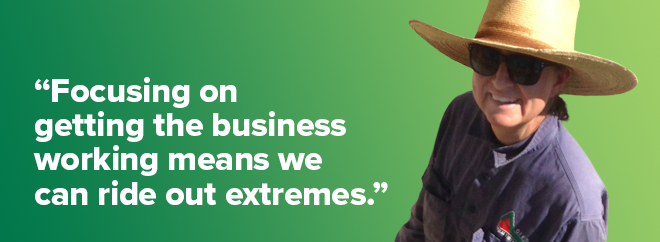Health and productivity focus helps ride out extremes
25 June 2021

Nina House knows a thing or two about dealing with uncertainty. Along with her parents, Ashley and Margaret, Nina has sustained the House family beef-breeding business in central west Queensland through the past seven years of drought.
The House family has bred beef cattle at Aramac in the Desert Uplands since 1983. Their herd is predominantly Brahman, with some crossbred cows. They mostly turn off weaner steers, fat cull cows and some excess heifers.
“We live in a very harsh environment with a high rate of drought and floods,” Nina said.
“That has taught us how to deal with extremes and not to rely on rain. We’ve noticed the last decade has become more extreme, particularly with the higher temperatures.”
Seven years ago, the Houses expanded their property, bringing their total to 39,000ha. At the time they had 1,400 breeders, but after seven years of drought this is now down to about 800 breeders plus anywhere from 200–400 replacement heifers and young stock.
“We have very old soils, which are phosphorus deficient and nutritionally challenged, but they still support over 2,000 plant species. When growing conditions are good, our native grasses are not as nutritious as introduced species, but they are tough and are there for us in the drier times.
“Analysis of dung has shown that our livestock will ingest an average of 20–30% browse (or non-grass species), but at times this can be up to 60%.”
Improving the land
“We have been very fortunate to be able to retain a quorum of breeding stock over the past seven years. For us, this means focusing on animal health and working out how we can do more with less.
“We put a priority on fostering a healthy plant and soil environment. A healthy environment creates healthy production, which leads to a healthy business and ultimately that is important for our own family’s health,” Nina said.
Improvements to the environment include introducing rotational grazing, improving pasture composition and reducing the walking distance to water. On the management side they’ve taken a proactive approach, implementing a track and weigh system that allows them to target supplementary feeding where it is needed most.
“We expect our cattle numbers to increase as conditions improve and we still have some development work to do on both properties that should allow us to carry more stock,” Nina said.
“We use a four-paddock rotation system based on moving cattle roughly every six to eight weeks or when we need to bring them in, such as during branding or weaning. This means every paddock will get a wet season rest every second year. Our stocking rate is not too intense as we have had to nurse our breeders through seven below-average seasons.
“We are also introducing some different grass species and legumes. We don’t want to completely replace the natives, but by adding some diversity to the pasture, it takes the pressure off the native grasses, enabling them to recover a bit.”
Other improvements include reducing paddock size and adding more water points to reduce the distance that cattle need to travel to access water. They use Google Earth Pro to identify and map the optimal locations for water points and fencing for each land type to prevent overgrazing of the sweeter country.
Tools of the trade
Nina said the long-term forecasts were not something they could rely on in their region. Although the Houses follow the forecasts on the Bureau of Meteorology and use the Long Paddock FORAGE reports, they tend to use them to reinforce decisions that are firmly based on what is happening on the ground – for instance how much grass is in the paddock.
“The FORAGE reports are particularly useful for tracking ground cover and pasture growth. Our long-term experience on the land has given us a pretty solid understanding of our current situation – but these reports put the reality of the situation into words and numbers and make it easier to trust your instincts,” Nina said.
“I’m not sure whether we expect too much from forecasting – there is still much to be learnt about our climate systems.
“Probably the tool that we have found to be most effective at managing cattle in this variable environment is a weighing system with software that tracks the weight of each animal. Tracking weights and management activities has given us a much better understanding of our growth rates and what we can achieve in this variable environment,” she said.
“It means we can better predict how long it will take an animal to reach its target weight and identify those that will need supplements. We feed supplementary licks throughout the year because of the phosphorus deficiencies, but the scales allow us to customise our supplements for the different weight classes. For instance, we might draft out the smaller weaners and put them on a higher protein diet to bring them up to speed.
“In this environment, extremes are an everyday reality. By focusing on getting the production system working well, we put ourselves in the best position to ride out those extremes.”


